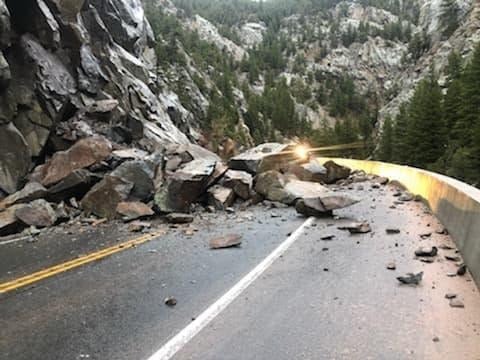With the spring weather finally warming things up in Colorado, it’s the time of year when rockfall becomes a major concern for drivers and hikers. The combination of freeze-thaw cycles, heavy snowmelt, and increased rainfall can cause rocks to become loose and unstable, leading to potentially dangerous situations for those traveling in the mountains.

In general, areas with steep slopes and loose or fractured rock are more susceptible to rockfall. Some examples of locations in Colorado that have particularly high rockfall risk in the spring include Glenwood Canyon on I-70, which has experienced multiple rockslides in recent years, and US 550 between Silverton and Ouray, which has narrow, winding stretches with steep drop-offs and loose rock. Rockfall in Colorado, an issue of the Colorado Geologic Survey’s newsletter Rock Talk, provides a great introduction to the causes of rockfalls and how to avoid potentially hazardous areas. The CGS website provides a deeper dive into rockfall information, including case studies of incidents in Manitou Springs, Glenwood Springs, and Castle Rock.
The Colorado Department of Transportation (CDOT) is tasked with monitoring and mitigating the impact of rockfall on the state’s highways. CDOT uses a combination of monitoring systems to detect and evaluate areas of concern. They also conduct regular inspections and maintenance to prevent rockfall from occurring in the first place. You can find research reports from CDOT scientists in our digital repository, many of which detail the research behind rockfall mitigation structures that you may have noticed on the side of the highway, like rockfall fences.
To avoid areas susceptible to rockfall during the springtime months, consult the CDOT’s travel updates to avoid active closures and use the information available in the reports linked above to avoid high-risk areas. Some broad but valuable advice from the Colorado Geologic Survey reads:
“It is important to be extra alert during three particular times on Colorado’s highways: spring thaw, after heavy rains, and at night. Be particularly alert during these times where you are approaching blind curves.”
Drive safely, everyone!
- Colorado’s Governors: Ralph L. Carr - July 11, 2025
- Celebrating Colorado’s immigrant heritage - June 27, 2025
- Colorado’s Scenic and Historic Byways: Guanella Pass - June 6, 2025